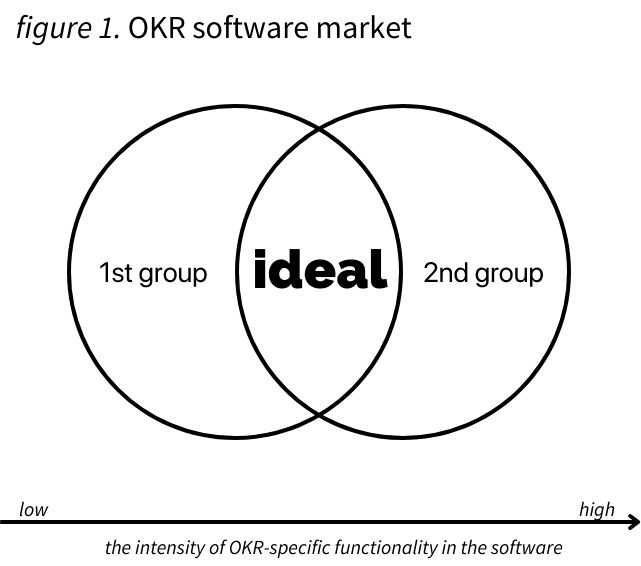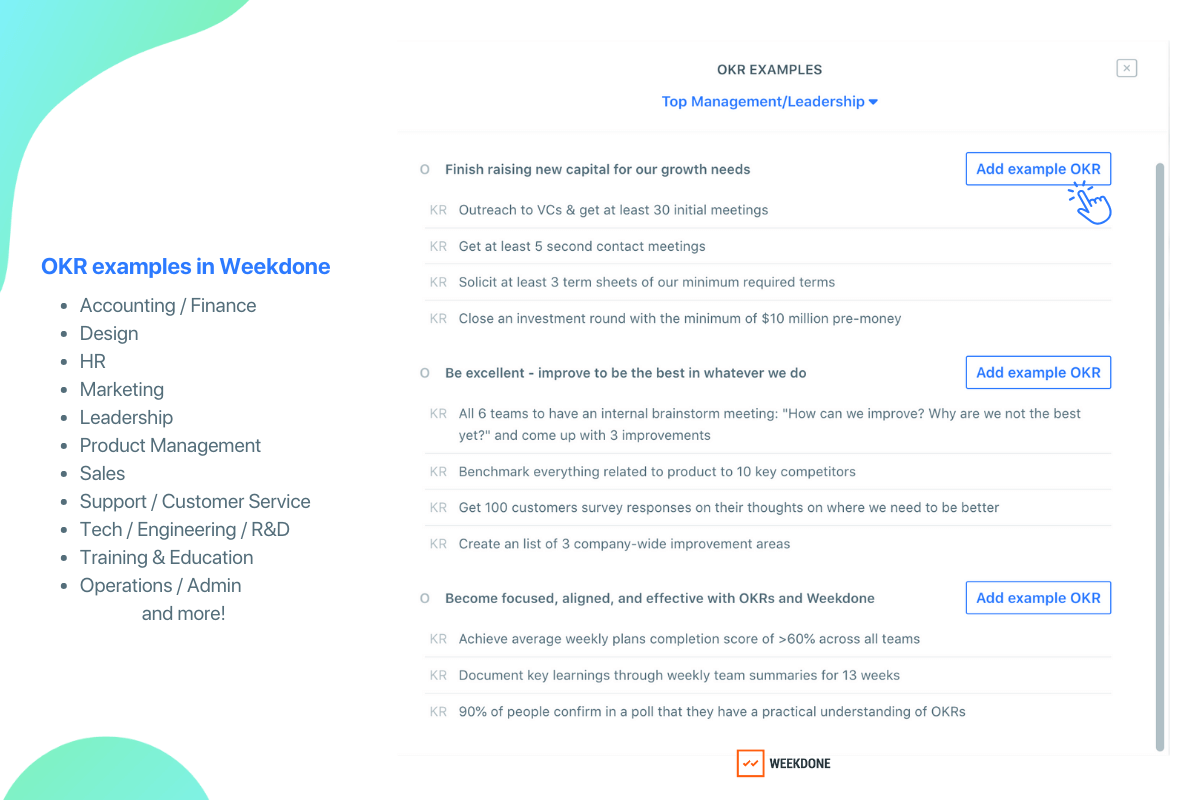In the dynamic landscape of organizational management, Objectives and Key Results (OKRs) have emerged as a popular framework to drive focus, alignment, and results. OKRs are one of the most comprehensive, innovative and proven goal-oriented management methodologies in the modern history of economy. From large corporations like Amazon, Facebook and Google right down to small public schools, OKRs have been delivering measurable results for years.
This article is supported by a case study constructed by Weekdone , a trusted market leader in the field of OKR software since 2013. We will explain how the playing field has changed, the problems that have occurred and finish with a back-to-basics guide to get you started. We’ll explain how making OKRs useful again through simplification will be the future.
There Is A Problem…
To understand, we should start from the beginning. Objectives and Key Results were first introduced to the larger audience 6 years ago with the book “Measure What Matters” written by John Doerr, an experienced investor. Originally, the OKR framework was advertised as a package of processes that increase clarity of direction and efficiency by changing the underlying work processes to be more transparent. This was noble – in the following years, thousands of organizations benefited from this and the market was happy. The good old times …

But something changed on the road to today, and it seems like OKRs have become a living ghost in the realm of organizational management – everyone knows about it, some love it, most don’t trust it.
In the beginning, OKRs used to be too simple. Every goal was acceptable as an OKR. Key Results pretty much covered everything else – tasks, projects, KPIs and metrics. Then the tables turned and OKRs became super restricted. Now the pendulum is once again changing direction.
Since the meaning of a framework is often defined by the software providers that provide information, we will explain the changes through the actions of OKR software providers while trying to keep the explanations clear and concise. No specific companies will be mentioned other than our own – no pointing fingers, we are simply trying to bring attention to the market and educate everyone on what we learned has happened.
Let’s get into it – roughly speaking, we’ll divide the world of OKRs into two groups.

The 1st Group – the “peacocks”
As OKRs gained prominence, it became a buzzword in the corporate world. This has led to a commodification of the term with software providers capitalising on its appeal without delivering the necessary functionality. The result is a market flooded with products that use the term “OKR” as a marketing tool, rather than embodying the principles essential for a functional framework. Examples of this sort of a tool usually consist of a simple task-type block called OKRs that you won’t be able to connect together nor execute any other additional activities related to a total OKR functionality.
But that is just one half of the problem – the other half, although seemingly paradoxical, is just as important to cover.
The 2nd Group – the “scientists”
While some software providers jumped on the OKR term for a quick buck, there were others that chose another extreme path – transforming OKRs from a useful tool to a comprehensive and high-level cult.
And, admittedly, we fell into the second category in Weekdone… It was a natural course of action to optimize the framework further to increase its value. Supporting the belief that OKRs have rules which have to be followed to gain any rewards limits one of the most essential OKR framework ideologies – flexibility. It is still important to evaluate what OKRs mean to your organization and follow your created structure – but the structure you create should be up to you. The software you use should support different adaptations of the OKR framework – one strategy doesn’t fit them all but good software must fit most of the strategies.

In retrospect, going overboard with the functionality allowed us to see the whole spectrum and analyze it – we are glad to say that we have evolved and by sharing our insights, we hope to share the new wave of OKRs to a larger crowd.
The ideal is found in between, taking the best of both worlds. Great OKR usage has its structure and rules to keep numbers and goals comparable. It doesn’t take itself too seriously – allows some flexibility and promotes connection to individual daily actions.
OKRs are not magic
OKRs are not magic, they don’t work themselves. We have seen time and time again that when companies learn about the OKR framework, they somehow often think of it as a fix-it-all cure for their poor team management. The higher-up leaders read about the framework and without any further focus, enter into the software with the entire company blindly. This results in confused staff and poor OKR structure that eventually ends in disaster, No structure is created, no process of updating OKRs has been agreed upon. The whole system is standing on the hope that the OKR framework is going to build itself and bring success to a company. We will give our insights and help you learn how to avoid falling into this mind of thinking. If you’re impatient, you can skip to The Cure. Here are some of the more common issues people have with OKRs:
| Problem | Solution |
| The economic recession and lack of financial resources restrain us from adopting a new system… Work needs to be done. | Sometimes taking a step back to look over your plan is better than keeping running forward with no clear direction in mind. Something to think about. |
| We tried OKRs but didn’t follow up on them | Just adding OKRs is one thing. Without actively working on them and updating their progress as time goes on, you’ll end up failing in the results and that turns you away from the methodology. |
| OKR didn’t fit into our current processes | It is smart to begin with the 80/20 mindset – start small, see what parts of your current management process could be solved with OKRs and work on them. Don’t try and rebuild everything you’ve created over the years, it will fail. |
| We are still doing our OKRs in spreadsheets and it’s fine | For some very small teams, doing OKRs in spreadsheets works – and that’s great. But when your team gets larger and no longer works together all the time, a software that allows good OKR overview, information on updates and weekly work planning will begin delivering more value. |
| We tried a simple OKR tool but it didn’t bring us any results | A common mistake many companies make is choosing the wrong software to begin with. As mentioned before, many of the current software providers use the OKR term as a sales term without offering many actually supportive features for completing OKRs. Consider choosing a software that is flexible and customizable. |
The Cure
Real work is done by people
OKRs are often misrepresented and misunderstood as the one framework that will fix all problems. This is not true for neither OKRs nor any other framework – the real work is done by people. The framework is just a guide that allows your people to direct their efforts towards a unified goal. This will result in obvious productivity gains and a better overall awareness of situational circumstances. A critical aspect of OKR success lies in the seamless integration of objectives with daily work. Unfortunately, many organizations struggle to establish this connection due to the absence of adequate solutions. The failure to embed OKRs into the daily workflow hinders progress, rendering the framework ineffective in driving continuous improvement.
Best results with achieving your OKRs come from a strong weekly rhythm by team leaders and all employees. It involves three things:
- regular weekly check-ins. This involves updating key results and projects progress, adding insights and lessons learned, discussing and commenting on updates.
- making OKRs the backbone of your weekly team meetings. Almost all teams have some form of a weekly standup, be it a call or real get-together. Always start those by looking at your OKRs progress, update and adjust as needed.
- starting your personal work week by looking at the OKRs and adjusting the weekly work projects and tasks under them. Some do it on Friday, some Monday morning. You need to plan your work week based on the OKR guidance.
Done is better than perfect – 80/20
The OKR methodology should not be a cult. It was not meant to be followed like one and does not fix all of your problems. Starting off with OKRs must not be too complicated. Think of how your company’s current processes and aspirations could be broken down into long term goals and start tracking them – don’t be afraid to fail the goals or worry about wording them. We often lose interest in doing something when it becomes a chore – that’s precisely why you should remember to keep it simple, but keep it going. This type of approach will give you insights and you’ll find that in time you are going to become more experienced in OKRs and establish strategies, which will naturally result in better OKR usage. Don’t be afraid to get it poorly set up the first time.
Remember – the ideal is found in between, taking the best of both worlds.
What we’ve learned over the years is that those whose current work processes only change up to 20% in the first year following the start of using OKRs, will statistically deliver better results in both the short and long term adaptation. If you try to change how your team and people work in a radical way you’re more prone to fail. Start from small improvements. Taking your time decreases potential miscommunication within the company, stress of delivering results in new ways and forming new habits.
Weekdone’s Efforts
After being the OKR market leader for over 10 years, we’ve had many pivots and redesigns of the product to cater new needs for our clients. Once again, we’re seeing a new chance to further increase the efficacy of the OKR process in our product. As previously mentioned, the weekly and ultimately, daily work has to be easily connected with long-term higher level OKRs to deliver sufficient results.
We’re proud to present our solution – one of the most flexible and customizable goal trees available on the market today. I’m going to break it down – first explaining the different objects and then demonstrating the flexibility of building a process in Weekdone. Stay with us, it’s awesome.
Let’s start off by demonstrating the object types we offer:
| Object type | Available on | Description |
| Objective | company, department, team, personal | An aspirational goal, set on different levels, explains the general direction of the group of teams or individuals |
| Key Result | company, department, team, personal | The actionable steps for completing the Objective. Higher level Key Results can be set as lower level Objectives by assigning |
| KPI – Key Performance Indicator | company, department | KPIs display the numbers a company always has to follow to function – such as ARR |
| Project | company, department, team, personal | Projects are trackable, individual or shared blocks of work that take longer than a week to finish |
| Weekly Item | personal | Weekly Items – plans, progress and problems are the lowest blocks of the goal tree structure. They are the inputs and outcomes of individual work that every team member is responsible of adding, updating and executing. |
Now that we’ve laid out and explained all of the different object types, the rest is simple. Think of the objects as building blocks, use them like Legos to build a structure that best fits to your needs.
We’ve tried our best to go through our hundreds of pages of OKR materials and create one fit-it-all guide for simply getting started with OKRs. And as always, we eventually find that the simplest way to understand something is through games.
Imagine being a competitive gamer. One of your main aspirations might be to become a gaming master in your choice of game. And let’s say that you’ve figured out a strategy on how you’re going to achieve that. To become a gaming master, you would have to increase your current average daily score by 50 points, successfully learn and execute three new competitive strategies to be used in different situations and practice at least 30 hours each month so 30×3=90 hours each quarter. Sounds like a reasonable plan – and something like this is perfect for an OKR – it can be blocked out and even tracked on a daily basis. Let’s go through it.
Let’s start with the name of the objective: Become a Gaming Master
Then, we would create 3 Key Results for that Objective as follows (in the brackets you’ll see the set range of the specific KR metric that you’ll track throughout the quarter):
- Increase your average daily score by 50 points (100->150 points)
- Learn and execute three new competitive strategies (2->5 strategies)
- Practice 90 hours (0-90 hours)
And there we go. As you read it through a couple of times and start making sense of the OKR logic, try and replace the example texts with something that may be relevant to your company – this will help you get started. Alternatively, create a free account in Weekdone and test there – you might find the extra resources, example OKRs database and a simple UI to be helpful when learning to use OKRs. Once again, don’t be afraid to not get it perfect the first time.
The following is an example screenshot of a relatively complex goal tree shown in the Tree view inside the Weekdone product. Yours may look simpler, this just illustrates what is possible in the future if you keep going.

Some more examples of potential goal tree structures for inspiration:
- Company Objective -> Company Key Result (assign to a team to add it as their Objective)-> Team Objective -> Team Key Result -> Personal Objective -> Personal Key Results -> Weekly Item
- Company Objective -> Company Key Result -> Department Objective -> Department Key Result ->
However you wish to structure your goal tree, remember – the last step should always be the personal Weekly Items people work on. This is crucial to connect your goal tree to the real work. Start using Weekly Items actively!
Some OKR Examples to Get You Started
Objective: Launch new, clearer landing page to drive action
KR1: Test existing landing page with at least 100 external users
KR2: Analyze previously reported feedback and agree on 10 biggest design issues to fix
KR3: User-test page prototypes with 12 people to work out usability issues
KR4: Achieve 80% positive feedback score from testing sessions
Objective: Finish raising new capital for growth needs
KR1: Outreach to VCs & get at least 30 initial meetings
KR2: Get at least 5 second contact meetings
KR3: Solicit at least 3 term sheets of our minimum required terms
KR4: Close an investment round with the minimum of $10 million pre-money
Objective: Implement first quarter OKRs process successfully
KR1: All team managers (10 total) attend Weekdone Theory and Usage training (free)
KR2: Each team (5 total) set at least 1 good Team OKR
KR3: Each team manager holds 12 weekly check-in meetingsKR4: Each team communicates 3 lessons learned using OKRs to the whole company
